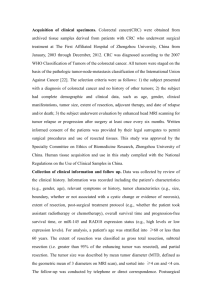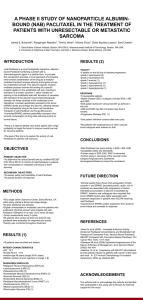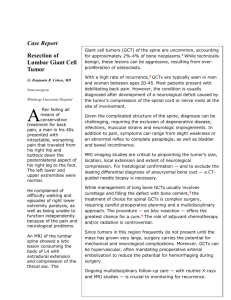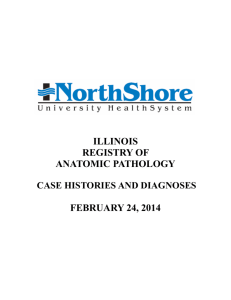to word document
advertisement
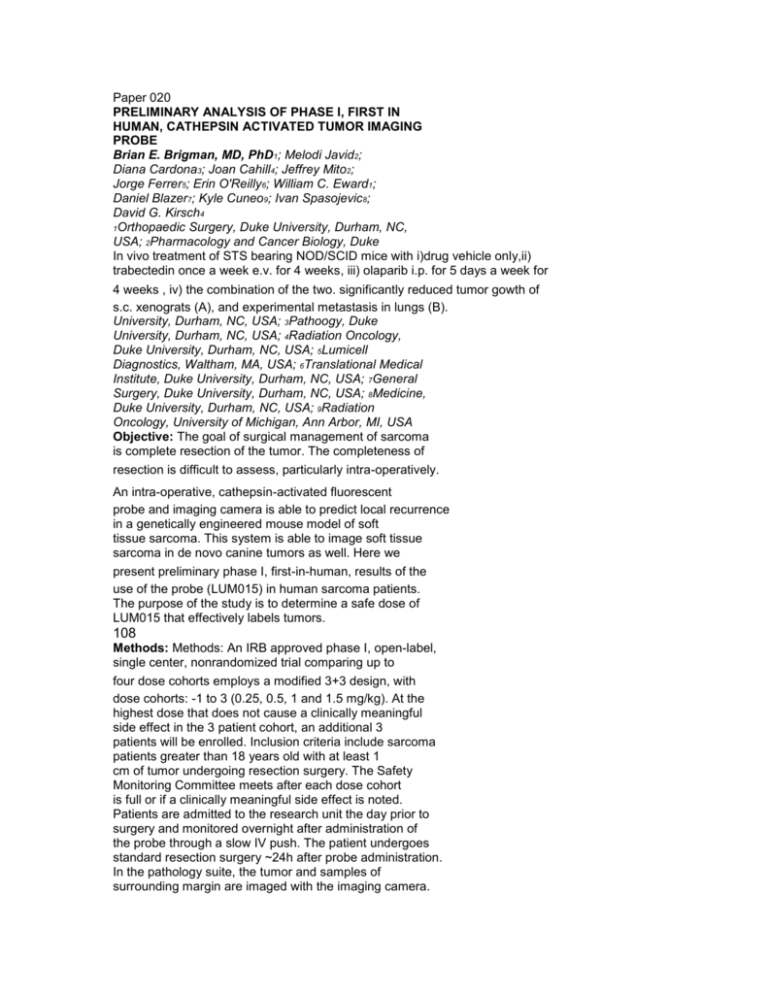
Paper 020 PRELIMINARY ANALYSIS OF PHASE I, FIRST IN HUMAN, CATHEPSIN ACTIVATED TUMOR IMAGING PROBE Brian E. Brigman, MD, PhD1; Melodi Javid2; Diana Cardona3; Joan Cahill4; Jeffrey Mito2; Jorge Ferrer5; Erin O'Reilly6; William C. Eward1; Daniel Blazer7; Kyle Cuneo9; Ivan Spasojevic8; David G. Kirsch4 1Orthopaedic Surgery, Duke University, Durham, NC, USA; 2Pharmacology and Cancer Biology, Duke In vivo treatment of STS bearing NOD/SCID mice with i)drug vehicle only,ii) trabectedin once a week e.v. for 4 weeks, iii) olaparib i.p. for 5 days a week for 4 weeks , iv) the combination of the two. significantly reduced tumor gowth of s.c. xenograts (A), and experimental metastasis in lungs (B). University, Durham, NC, USA; 3Pathoogy, Duke University, Durham, NC, USA; 4Radiation Oncology, Duke University, Durham, NC, USA; 5Lumicell Diagnostics, Waltham, MA, USA; 6Translational Medical Institute, Duke University, Durham, NC, USA; 7General Surgery, Duke University, Durham, NC, USA; 8Medicine, Duke University, Durham, NC, USA; 9Radiation Oncology, University of Michigan, Ann Arbor, MI, USA Objective: The goal of surgical management of sarcoma is complete resection of the tumor. The completeness of resection is difficult to assess, particularly intra-operatively. An intra-operative, cathepsin-activated fluorescent probe and imaging camera is able to predict local recurrence in a genetically engineered mouse model of soft tissue sarcoma. This system is able to image soft tissue sarcoma in de novo canine tumors as well. Here we present preliminary phase I, first-in-human, results of the use of the probe (LUM015) in human sarcoma patients. The purpose of the study is to determine a safe dose of LUM015 that effectively labels tumors. 108 Methods: Methods: An IRB approved phase I, open-label, single center, nonrandomized trial comparing up to four dose cohorts employs a modified 3+3 design, with dose cohorts: -1 to 3 (0.25, 0.5, 1 and 1.5 mg/kg). At the highest dose that does not cause a clinically meaningful side effect in the 3 patient cohort, an additional 3 patients will be enrolled. Inclusion criteria include sarcoma patients greater than 18 years old with at least 1 cm of tumor undergoing resection surgery. The Safety Monitoring Committee meets after each dose cohort is full or if a clinically meaningful side effect is noted. Patients are admitted to the research unit the day prior to surgery and monitored overnight after administration of the probe through a slow IV push. The patient undergoes standard resection surgery ~24h after probe administration. In the pathology suite, the tumor and samples of surrounding margin are imaged with the imaging camera. Specimens from imaged areas are harvested for histological evaluation and cathepsin measurement. Results: Results: At the time of abstract submission, 5 patients had been enrolled (cohorts 1 and 2). No clinically meaningful side effects were noted. Analysis of the LUM015 concentration-time curve for dose 1 cohort (0.5 mg/kg) gave a maximum serum concentration (Cmax) = 14.5±1.5 μg/mL, area under curve (AUC) = 79.8±8.7 hr μg/mL. The curve had a triphasic appearance with a serum half life of 3-4 h. We have been able to differentially label tumor and normal tissue. Conclusion: Conclusion: Preliminary results of LUM015 in human patients indicate that the drug is safe and well tolerated at the dosages that have been given and that we can differentially label tumor and normal tissue. Additional patients will be enrolled at higher dosing cohorts to better evaluate safety, pK and labeling efficacy. Fluorescent imaging (top) and correlative histology (bottom) from multiple areas of a single case of undifferentiated pleomorphic sarcoma in a human patient. Paper 021 INFILTRATIVE SOFT TISSUE SARCOMA SHOULD WE EXCISE BEYOND RADIOLOGICAL INFILTRATION? Shintaro Iwata, MD1; Tsukasa Yonemoto1; Akinobu Araki2; Dai Ikebe2; Hiroto Kamoda1; Yoko Hagiwara1; Takeshi Ishii1 1Div.Orthopaedic Surgery, Chiba Cancer Center, Chiba, Japan; 2Div.Surgical Pathology, Chiba Cancer Center, Chiba, Japan Objective: Tumor infiltration, frequently observed in spindle cell sarcomas of soft tissue, is often associated with an inadequate surgical margin and results in failure of local control. The purpose of this study is to determine whether radiological tumor infiltration in spindle cell sarcomas correlates with histological infiltration and whether tumor resections with infiltration-free margins improve their local control. Methods: We retrospectively reviewed 41 patients diagnosed with myxofibrosarcoma, undifferentiated pleomorphic sarcoma, and leiomyosarcoma who underwent initial surgery at our institute between 2007 and 2011 . Radiological infiltration (R-inf) was measured by the length of high-intensity tail-like extension as observed in either STIR or gadolinium-enhanced fat-suppressed (GdFS) MRI. Histological infiltration (H-inf) was defined as the distance from the tumor edge to the end of the atypical tumor cells on the histological mapping described by musculoskeletal tumor pathologists (Fig.1). Correlation between R-inf and H-inf was analyzed using the Pearson's correlation coefficient. Local control rate (LCR) and overall survival (OAS) were analyzed using the Kaplan-Meier method, and the association of potential prognostic factors with LCR and OAS were analyzed using the log-rank test and the Cox proportional hazards regression model. Results: Four patients (9.8%) out of 41 showed local failure. Five-year OAS and LCR were 81.5% and 89.4%, respectively. R-inf (range, 0-67mm) and H-inf (rang, 060mm) were observed positive in 19 (46%) and 20 (49%) 109 patients, respectively. R-inf obtained by GdFS MRI images (R2=.59) showed a stronger correlation to the H-inf than that obtained by STIR image (R2=.28) (Fig.2). Univariate analysis with 5-year LCR demonstrated that a positive margin with not only tumor mass but also infiltrative tumor cells was a significant prognostic factor compared with a wide margin (p=.0017). Positive R-inf (p=.0047) and Hinf (p=.047) were also significant factors predicting local failure. In the multivariate analysis, wide resection with an infiltration-free margin remained a significant factor predicting favorable local control. Fig.1 Radiological infiltration (R-inf) and Histological infiltration (H-inf). Fig.2 Scatter plot showing H-inf versus R-inf. Conclusion: Radiological infiltration of spindle cell sarcoma as assessed by GdFS MRI images correlated with histological infiltration. In addition, our results suggest that wide resection with an infiltration-free margin would improve local control of these sarcomas.


